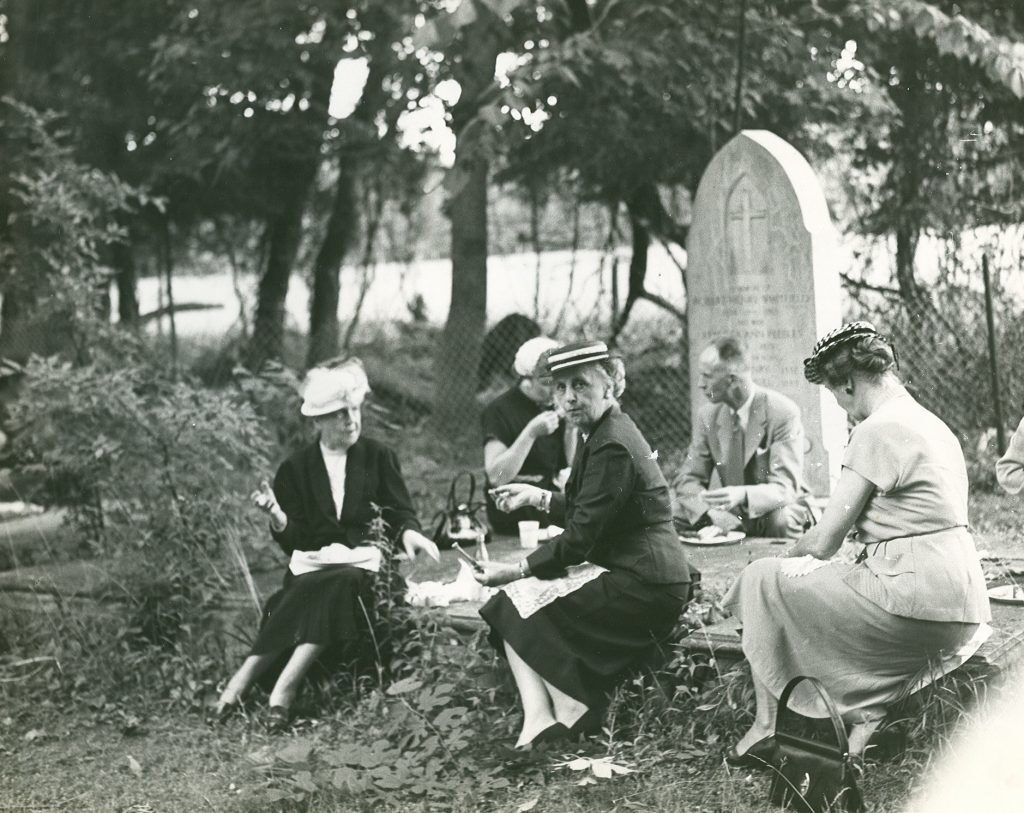The COVID-19 pandemic has led to the isolation of millions of people, to creative and responsible actions by many others, and to irresponsible behaviors by way too many people who refuse to wear masks, refuse to keep social distance, and genuinely believe that Coronavirus is a “hoax.”
The Way Out performance series by cutting-edge theater artists and aerialists not only presents stunning live performances, but comes with a lot of thought behind it to create a safe environment for audience members driving by in their cars, on their bicycles or tandems, exploring Philadelphia’s historic Laurel Hill Cemetery at night with six different performance stations [read the preview here]. The demand for limited tickets is so great that these artists are already planning another show in the spring.
Henrik Eger asked some difficult questions in an interview with some of the cast members, leading to a few thought-provoking responses.

Questions, Answers, Insights
Henrik Eger: As a child and/or as an adolescent, what was your greatest fear in life, and how did you conquer it as an adult through dance or other creative arts?

Lauren Rile Smith (performer, poet, producer, and Tangle Movement Arts founder): I’m genuinely afraid of heights, so much so that you won’t catch me on top of a mountain! However, training and performing on trapeze allowed me to slowly adjust what “high” means to me.
I take inspiration from our setting at Laurel Hill Cemetery, a beautiful green space and historic burial ground that dates from an era before public parks. Our Victorian ancestors would visit graveyards to spend time with their dead as well as their living friends and family.
During our COVID-19 pandemic, we’re constantly shadowed by a fear of mortality. Performing in a cemetery reminds me that loss always surrounds us—making death less scary.

Evalina “Wally” Carbonell (dance artist and choreographer): At home as a child, in my odd artist’s spirit, I was boldly unusual.
As an adolescent, I grew self-conscious, worrying that I should somehow tone myself down to be more accepted. However, I grew into an adult when I reclaimed myself, unafraid to see the world differently and eager to connect with other souls I would encounter.
Since then, through dance-making, I’m learning more about myself and find new ways to communicate with the world. The ability to open myself up to my surroundings is essential to being able to embody the connections which our dance piece requires.
Yes, I owe much to dance.
Henrik: Could you describe the scene that you and your team partner/s are performing at the cemetery?

Christina Eltvedt (multidisciplinary artist, performer, and choreographer): The scene my dancers and I have developed for The Way Out plays with the concept of unraveling through movement and textiles. Collectively, we live in a period of drastic change and reordering. The unraveling of the known and familiar scares many of us and makes us feel uncomfortable. I’m looking for hope through weaving beauty into something new.
Eppchez! (music and theater artist): The scene I have created uses vocal looping and choreography to evoke the cycles of isolation and release—so common during these prolonged periods of semi-quarantine. The loops reflect the warped sense of time we’ve all been experiencing. While our interactions have shifted drastically, we still attempt to continue living—one day after another.
Evalina “Wally” Carbonell: The scene we are creating for The Way Out illuminates connections between femininity and nature. Our blood has memories, as does the earth, and they speak to each other in a curving, heated flow of movement. “Blood is that fragile scarlet tree we carry within us,” wrote Sir Osbert Sitwell, brother of Dame Edith Sitwell, the poet. This awareness informs our connection to the natural world within Laurel Hill Cemetery.

Ama Gora (dancer and choreographer): Assata Shakur, a former Black Panther party member, inspired this work, Project Assata: Conscious States of Rage, which questions timelines of rioting, organizing, and protesting. Observing how rage drove—and drives—these movements, I question how black femmes are taught that “rage is distasteful.”
This scene also observes healing through a generational lens as a way of reclaiming our freedom of expression, our pain, and our healing. I’m trying to create a haunting presence, with reference to dance scholar Thomas DeFrantz [Queer Social Dance, Political Leadership, and Black Popular Culture]. We cannot ignore our dance lineage as ancient dancing spirits accompany us.
Creating shadowy vignettes with a lot of progressional phrase work, I want people to ask, “Are the dancers moving? What’s happening?”
Lauren Rile Smith: For our performance, Tangle’s aerial dancers are suspended on our freestanding aerial rig, discovered at the end of our audience’s path throughout the historic Laurel Hill Cemetery. Caught within the bubble of the rig, our aerialists climb towards the sky and return to the ground.
Henrik Eger: What aspects of your life influenced your scene at Philadelphia’s most historic cemetery?

Eppchez!: As a visibly queer and trans person, it is impossible to separate the queerness from my work. So often I find my mere presence pushes buttons, upsets the status quo, and I have to do a lot of coddling and educating if I want to share space with cis people. When I’m on stage, I can do the emotional labor dance much more on my terms.
Ama Gora: I use she/her/we pronouns. To acknowledge the communities, ancestors, and deities that carry and hold me as a queer black woman, I’ve embraced “we.” I find that my queerness is always a part of my work. It may not be the central theme in works like Project Assata, but it creates an ever-present dialogue about queerness.
Queer black femme folk have been and continue to pick up the broken pieces when things have crumbled. I have to acknowledge that, address it, and continue to create space for dialogue around it—despite any controversy and push back I may receive.
Henrik Eger: What would you like your audience, driving by in cars like a slow-moving funeral procession, take home with them and share with others—perhaps getting new perspectives of life from all of you?
Evalina “Wally” Carbonell: I would like them to tune into the blood in their own veins and be appreciative of the life force within them and that of their neighbors. Ideally, I would like them to listen to the ancient mysteries that live within them, communicating secrets of humanity to their environments.
Christina Eltvedt: I like to present an idea with enough room embedded to reflect and craft a personal outlook. I want audience members to take what they need from my work.
Eppchez! : I try not to worry too much about what the audience takes away—that is their prerogative and entirely in their hands. Four and a half minutes is not a lot of time to get much across. However, through this performance I hope to offer the realization that we need to do better than return to a normal that was untenable for millions of people.
We may not be able to interact intimately in this time, but we can still find ways to build the kinds of community that will get us through the deep winters that are coming. Not alone, holed up in the woods with our one million calories, but together in our neighborhoods—sharing all the resources we may not even realize we already have.
Lauren Rile Smith: In this show, all of our artists seek to answer, “What is the way out of our current moment?” Frequently, this question shows up in small and in large ways in our lives—as reflected in each performance in The Way Out.
Seeing others work through these vital issues gives me new perspective and strength in my own work. Through a half-dozen tiny worlds, The Way Out hopes to show our audience possibilities and transformations.
Sometimes, “this moment” feels like it started in the middle of March, while at other times, it feels like one endless, frustrating afternoon. For some, a marriage or a job needs escaping. For many, it’s a struggle that can be traced back decades, even centuries.
Henrik: Thank you all for taking risks through your contributions of The Way Out. Thank you for opening up and generating new life at one of the oldest cemeteries in Philadelphia.
“Open Sesame!”
WHERE: Laurel Hill Cemetery, 3822 Ridge Ave, Philadelphia, PA 19132.
WHEN: Thursday October 1, Friday October 2, and Saturday October 3. All performance times are rolling (7pm-8:30pm). Rain date: Sunday, October 4.
TICKETS: $100 tickets per car, not per audience member. $25 tickets for individuals on bicycles may be announced in September if COVID-19 safety permits.
Because of the COVID precautionary measures, only a few people are allowed in, leading to a very limited number of tickets—all of which are only sold in advance, making for a contact-free box office experience. Call 215-266-6215 for tickets. Upon arrival, audience members who already paid for their tickets will be checked in via the same telephone number.
Throughout the entire performance, audiences will stay in their vehicles. There is no restroom access on site. Contact info@tangle-arts.com or call 215-266-6215 with questions.
